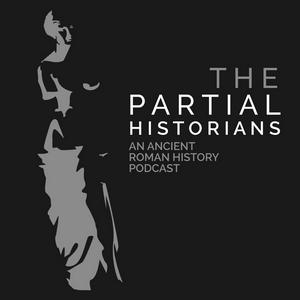202 episodes

The Gallic Sack of Rome - Part 3
18/12/2025 | 56 mins.
In this episode, we discuss one of the more tragic episodes from the Gallic sack of Rome. We Who Are About to Die…The Romans who have remained in the city take up their defensive positions on the Capitol. The old patricians did not join them. Instead, their retired to their houses. Wearing their old robes of state, they settled down in the middle of their houses on ivory chairs to await the end. Livy reports that some of his accounts indicate that the pontifex maximus (chief priest) led the ex-magistrates in a vow, in which they were devoting themselves to death for the sake of the city and its citizens.The Gauls found their blood had cooled; after all, they had not had to fight the Romans to seize control of the city. They had just wandered in. They could see that the Capitol had been fortified, so they kept an eye on that area. However, it was time to go SHOPPING! All these abandoned streets and houses – it was theirs for the taking. After some pillaging and plundering, the Gauls touched base again in the Forum. The plebeian houses in the area were locked up – they weren’t taking any chances whilst they were out of town. But the houses of the elite were mysteriously open.As the Gauls entered the patrician dwellings, a shocking sight met their eyes. The old ex-magistrates, sitting as still as statues, dressed in their robes of state, just waiting for them. Not quite believing their eyes, one of the Gauls reached out to touch the beard of one of the patricians. How rude! The patrician clocked him in the head with an ivory mace. The Gauls were not going to show restraint now. The patricians were slain, the houses of the Roman citizens looted, and finally, the city was set on fire. But not the whole city – these Gauls weren’t FOOLS! They wanted to keep a bargaining chip in their back pockets. Maybe these pesky Romans on the citadel might surrender to save their homes? The Romans in question were in their own kind of hell as they sat on the Capitol and had to watch the destruction. Fortune had turned her back on them.Did this mean that the Romans were going to give up? It most certainly did NOT! When the Gauls finally assaulted the Capitol, the Romans were ready for them. They managed to hold the line. If the Gauls wanted to seize all of Rome, they were going to have to settle in for a siege. As the Gauls made themselves comfortable and set about plundering the countryside, over in Ardea, the exiled Camillus heard of the attack on Rome. What could he do? Could he possibly whip up an inspirational speech and persuade the Ardeates to fight the Gallic invaders? You betcha! Things to Look Out For: · Dazzling rhetoric · Far too much bloodshed · Silent, manly tears from the Romans on the Capitol · Ye olde time Roman racism · The Gauls putting on a SHOW of destruction for the RomansFor our full show notes and edited transcripts, head on over to https://partialhistorians.com/Support the showPatreonKo-FiRead our booksRex: The Seven Kings of RomeYour Cheeky Guide to the Roman Empire Hosted on Acast. See acast.com/privacy for more information.

Camillus with Marc Hyden
11/12/2025 | 43 mins.
Marcus Furius Camillus is an ancient Roman that it is hard to ignore, especially in the early days of the 4th century BCE. He has been regularly popping up in our episodes from the era, so we thought it would be wonderful to invite on a special guest to discuss his whole life in one handy biographic episode. Who is Marc Hyden?Marc Hyden is the Director of State Government Affairs at a Washington DC-based think tank, as well as being a weekly columnist for the Newnan Times-Herald, Albany Herald, and Rome News-Tribune. Marc graduated from Georgia State University with a degree in philosophy. Marc has authored many, many books on Ancient Rome. His most recent work is Emperor Titus: The Right Hand of Vespasian (McFarland, 2025), and we will be talking with him about that in a future episode. He has also authored Gaius Marius: The Rise and Fall of Rome’s Saviour (Pen & Sword, 2017), Romulus: The Legend of Rome's Founding Father (Pen & Sword, 2020), but our focus today is going to be on Marcus Furius Camillus: The Life of Rome’s Second Founder (Pen & Sword, 2023). Things to Listen Out For: · Camillus’ controversies · Camillus’ rise to fame · The many virtues of Camillus · The legacy of this Roman hero We are sure you will love hearing Marc talk about Camillus, the man who served as a role model for later Roman luminaries like Julius Caesar and Augustus. If you would like to hear more, we have a stack of episodes in our back catalogue that feature Camillus. Sound CreditsOur music is by Bettina Joy de GuzmanFor our full show notes and edited transcripts, head on over to https://partialhistorians.com/Support the showPatreonKo-FiRead our booksRex: The Seven Kings of RomeYour Cheeky Guide to the Roman Empire Hosted on Acast. See acast.com/privacy for more information.

The Gallic Sack of Rome - Part 2
27/11/2025 | 1h 2 mins.
Episode 167 - The Gallic Sack of Rome - Part 2We rejoin the Romans and the Gauls in 390 BCE at the place where the Tiber river intersects with the Alia river. Turns out that when a bunch of Fabians upset the Gauls, those Gauls decide to march south towards Rome… How many Gauls and how many Romans met at the rivers’ edge? Well, the numbers are probably unreliable but the Romans are pretty sure they are outnumbered.The Battle at the AliaThere seems to be a few issues at this moment including the Roman failure to build a proper camp and - even worse - failure to take the auspices. Is this some foreshadowing from our friend Livy?Stay tuned for a discussion of the slim layout of the Roman forces. Brennus, the putative leader of the Gauls, seems to be uncertain that there may be some secret tactic or force that he hasn’t been able to account for. There’s also the problem of which bank of the river the battle takes place on which may influence where Roman forces end up. Will the Romans take the day or will they flail in the face of the Gallic strength? Are there some tactics involved that scholars can discern from the literary accounts that aren’t immediately obvious?The Roman Retreat When the day goes against Rome, the retreat seems to be chaotic. Some of the Romans retreat to Rome, which makes sense, and some retreat to Veii. This creates a host of uncertainty for the Romans who survive particularly those who head back to Rome and don’t find their comrades there. The assumption of Roman losses is significant.The Gauls meanwhile continue to suspect that there is a surprise attack from the Romans coming, but after some time they decide it’s worth marching on Rome just to see what they can see. Things to listen out for:Gauls getting ‘organised’ after AliaThe priestesses of Vesta get involvedGeneral Akbar and the Gauls coming togetherThe role of the citadel on the Capitoline HillThe Gauls confused about Rome - the city?How does the levy of the Roman army work in this moment?The security of the sacred objects of RomeThe Vestal Virgins on the move!What happens to the eldest noble Romans now the Gauls are at the gatesLucius Albinus - ’the noble Plebeian’?For our full show notes and edited transcripts, head on over to https://partialhistorians.com/Support the showPatreonKo-FiRead our booksRex: The Seven Kings of RomeYour Cheeky Guide to the Roman Empire Hosted on Acast. See acast.com/privacy for more information.

The Gallic Sack of Rome - Part 1
06/11/2025 | 57 mins.
We’re about to embark on a stunning period of Rome’s history in the middle Republic. Strap yourself in, this one is going to a take more a couple of episodes. We are, of course, dealing with the years that were 391/390 BCE. We begin with some of the important details that emerge for the latter part of 391 BCE which will have flow on effects for 390 BCE, which is the big ticket year that we’ll be navigating in this episode.The title may have given a little away, but the Gauls are in Italy. North Italy specifically, but they are going to be travelling south and pretty soon they arrive on the doorstep of Clusium.Clusium, Rome's new bestie?The Etruscan people of the city of Clusium seek support from the Romans. Unusual, yes, good for storytelling, also yes. Clusium is deep in Etruscan territory and yet it seems the Romans are willing to send a delegation to see what the Gaulish fuss is all about. The delegation is made up solely of Fabians, who are apparently meant to be neutral, but that aspect of the situation falls away pretty quickly when one of them kills a leader of the Gauls...The Battle of the AliaRome (and particularly the Fabians) have really upset the Gauls so much so, that the Gauls make a bee-line for Rome moving swiftly through Etruscan territory to arrive at the point where the Tiber meets the Alia, just north of Rome. The speed of the Gallic movement catches the Romans off-guard and that's just the beginning of their woes.Things to listen out for:Who is King Brennus?“All things belong to the brave”Quintus Fabius gets right out of lineThe Gauls send envoys to RomeDiodorus Siculus - more accurate than Livy?Did Dionysius of Syracuse hire the Gauls as mercenaries?The search for somewhere cool?For our full show notes and edited transcripts, head on over to https://partialhistorians.com/Support the showPatreonKo-FiRead our booksRex: The Seven Kings of RomeYour Cheeky Guide to the Roman Empire Hosted on Acast. See acast.com/privacy for more information.

Central Italy and the Emergence of Rome with Dr Fulminante
16/10/2025 | 41 mins.
We are thrilled to sit down with Dr Francesca Fulminante to chat all about the development of settlements in central Italy from the Bronze Age to the Archaic Period of Rome. Dr Fulminante shares insights from her recent monograph: The Rise of Early Rome - Transportation Networks and Domination in Central Italy, 1050-500 BCE (2023) (Cambridge University Press).This is a period where archaeological investigation reigns supreme requiring researchers to get into the nitty gritty layers of settlement patterns and trading networks. We’re thrilled to learn from Dr Fulminante as her research involves the investigation of complex societies in central Italy during the Bronze Age, looking at things like social stratification, settlement organisation, and craft community practices. Dr Fulminate is a Senior Research Fellow in the Department of Anthropology and Archaeology at the University of Bristol, and is an Associate Professor at University Roma Tre. Her work also involves offering continuing education training at the Universities of Oxford and Cambridge.What is time and how do things get complicated quickly?Coming to grips with the early evidence for Rome and central Italy involves understanding some of the overlapping terminology used by archaeologists and historians, who are coming to the evidence from different perspectives. Terms like the Bronze Age and Iron Age come to us from archaeology and anthropology while specific periods like the Archaic period and Early Roman Republic are much more society specific and tend to come from historians. This overlap can create a little bit of confusion, so here’s a rough breakdown (including some of the overlapping terms):The Early Bronze Age: 2300-1700 BCEThe Middle Bronze Age: 1700-1350 BCEThe Recent Bronze Age: 1350-1150 BCEThe Final Bronze Age: 1150-950 BCEIron Age: c. 1200- c. 500 BCEVillanovan Culture: c. 900-700 BCE (Etruscan)The Orientalising Period: c. 700-500 BCE (Etruscan)The Archaic Period: 800-500 BCE (Rome)The Early Republic: 509-400 BCE (Rome)The Rise of Rome?Dr Fulminante takes us through the early settlements of the Bronze Age and the transition to permanent structures in stone rather than perishable materials that occurs in from the 8th century BCE onwards. What does the evidence suggest for the development of ancient cities and the interconnections between them? Tune in to find out!Things to listen out for:V. Gordon Childe’s ten defining features for an ancient cityConnectivity in central Italy as an essential feature of the growth of citiesBurial under the housesThe movement of cities from east to west versus the network development theoryHow transportation networks develop from a physical perspectiveHow transportation networks are are influenced by political organisation and relationshipsThe way roads and rivers work together to create a networkThe connections between Latium vetus (old Latium) and Etruria (north of the Tiber)Cooperative networks versus centralised hierarchical networksFor our full show notes and edited transcripts, head on over to https://partialhistorians.com/Support the showPatreonKo-FiRead our booksRex: The Seven Kings of RomeYour Cheeky Guide to the Roman Empire Hosted on Acast. See acast.com/privacy for more information.
More Education podcasts
Trending Education podcasts
About The Partial Historians
Listen to The Partial Historians, The Rich Roll Podcast and many other podcasts from around the world with the radio.net app

Get the free radio.net app
- Stations and podcasts to bookmark
- Stream via Wi-Fi or Bluetooth
- Supports Carplay & Android Auto
- Many other app features
Get the free radio.net app
- Stations and podcasts to bookmark
- Stream via Wi-Fi or Bluetooth
- Supports Carplay & Android Auto
- Many other app features


The Partial Historians
download the app,
start listening.
































